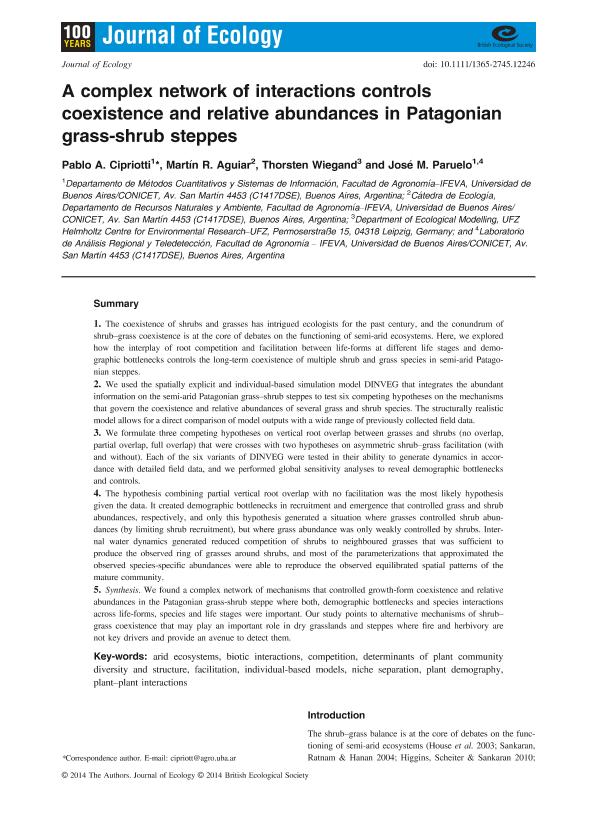Mostrar el registro sencillo del ítem
dc.contributor.author
Cipriotti, Pablo Ariel

dc.contributor.author
Aguiar, Martin Roberto

dc.contributor.author
Wiegand, Thorsten
dc.contributor.author
Paruelo, José

dc.date.available
2016-02-17T20:55:21Z
dc.date.issued
2014-02
dc.identifier.citation
Cipriotti, Pablo Ariel; Aguiar, Martin Roberto; Wiegand, Thorsten; Paruelo, José; A complex interaction networks controls coexistence and relative abundances in grass-shrub Patagonian steppes; Wiley; Journal of Ecology; 102; 3; 2-2014; 776-788
dc.identifier.issn
0022-0477
dc.identifier.uri
http://hdl.handle.net/11336/4246
dc.description.abstract
1. The coexistence of shrubs and grasses has intrigued ecologists for the past century, and the conundrum of shrub-grass coexistence is at the core of debates on the functioning of semi-arid ecosystems. Here, we explored how the interplay of root competition and facilitation between life-forms at different life stages and demographic bottlenecks controls the long-term coexistence of multiple shrub and grass species in semi-arid Patagonian steppes. 2. We used the spatially explicit and individual-based simulation model DINVEG that integrates the abundant information on the semi-arid Patagonian grass-shrub steppes to test six competing hypotheses on the mechanisms that govern the coexistence and relative abundances of several grass and shrub species. The structurally realistic model allows for a direct comparison of model outputs with a wide range of previously collected field data. 3. We formulate three competing hypotheses on vertical root overlap between grasses and shrubs (no overlap, partial overlap, full overlap) that were crosses with two hypotheses on asymmetric shrub-grass facilitation (with and without). Each of the six variants of DINVEG were tested in their ability to generate dynamics in accordance with detailed field data, and we performed global sensitivity analyses to reveal demographic bottlenecks and controls. 4. The hypothesis combining partial vertical root overlap with no facilitation was the most likely hypothesis given the data. It created demographic bottlenecks in recruitment and emergence that controlled grass and shrub abundances, respectively, and only this hypothesis generated a situation where grasses controlled shrub abundances (by limiting shrub recruitment), but where grass abundance was only weakly controlled by shrubs. Internal water dynamics generated reduced competition of shrubs to neighboured grasses that was sufficient to produce the observed ring of grasses around shrubs, and most of the parameterizations that approximated the observed species-specific abundances were able to reproduce the observed equilibrated spatial patterns of the mature community. 5. Synthesis. We found a complex network of mechanisms that controlled growth-form coexistence and relative abundances in the Patagonian grass-shrub steppe where both, demographic bottlenecks and species interactions across life-forms, species and life stages were important. Our study points to alternative mechanisms of shrub-grass coexistence that may play an important role in dry grasslands and steppes where fire and herbivory are not key drivers and provide an avenue to detect them.
dc.format
application/pdf
dc.language.iso
eng
dc.publisher
Wiley

dc.rights
info:eu-repo/semantics/openAccess
dc.rights.uri
https://creativecommons.org/licenses/by-nc-sa/2.5/ar/
dc.subject
Arid Ecosystems
dc.subject
Biotic Interactions
dc.subject
Competition
dc.subject
Facilitation
dc.subject.classification
Ecología

dc.subject.classification
Ciencias Biológicas

dc.subject.classification
CIENCIAS NATURALES Y EXACTAS

dc.title
A complex interaction networks controls coexistence and relative abundances in grass-shrub Patagonian steppes
dc.type
info:eu-repo/semantics/article
dc.type
info:ar-repo/semantics/artículo
dc.type
info:eu-repo/semantics/publishedVersion
dc.date.updated
2016-03-30 10:35:44.97925-03
dc.journal.volume
102
dc.journal.number
3
dc.journal.pagination
776-788
dc.journal.pais
Estados Unidos

dc.journal.ciudad
Hoboken
dc.description.fil
Fil: Cipriotti, Pablo Ariel. Consejo Nacional de Investigaciones Científicas y Técnicas. Oficina de Coordinación Administrativa Parque Centenario. Instituto de Investigaciones Fisiológicas y Ecológicas Vinculadas a la Agricultura; Argentina. Universidad de Buenos Aires. Facultad de Agronomía. Departamento de Métodos Cuantitativos y Sistemas de Información; Argentina
dc.description.fil
Fil: Aguiar, Martin Roberto. Consejo Nacional de Investigaciones Científicas y Técnicas. Oficina de Coordinación Administrativa Parque Centenario. Instituto de Investigaciones Fisiológicas y Ecológicas Vinculadas a la Agricultura; Argentina. Universidad de Buenos Aires. Facultad de Agronomia. Departamento de Recursos Naturales y Ambiente. Catedra de Ecologia; Argentina
dc.description.fil
Fil: Wiegand, Thorsten. UFZ Helmholtz Centre for Environmental Research. Department of Ecological Modelling; Alemania
dc.description.fil
Fil: Paruelo, José. Consejo Nacional de Investigaciones Científicas y Técnicas. Oficina de Coordinación Administrativa Parque Centenario. Instituto de Investigaciones Fisiológicas y Ecológicas Vinculadas a la Agricultura; Argentina. Universidad de Buenos Aires. Facultad de Agronomía. Departamento de Métodos Cuantitativos y Sistemas de Información; Argentina
dc.journal.title
Journal of Ecology

dc.relation.alternativeid
info:eu-repo/semantics/altIdentifier/url/http://onlinelibrary.wiley.com/doi/10.1111/1365-2745.12246/abstract
dc.relation.alternativeid
info:eu-repo/semantics/altIdentifier/doi/http://dx.doi.org/DOI:10.1111/1365-2745.12246
dc.relation.alternativeid
info:eu-repo/semantics/altIdentifier/issn/0022-0477
Archivos asociados
